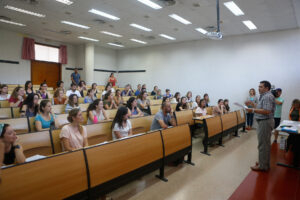There is a lot of competition in the Spanish job market, especially due to the rising rate of unemployment in recent years. Therefore, making sure that your resume is up to date and meets the expectations of local employers is imperative. Of course, it is also important to know what to expect during the job application and interview process and to have a good understanding of Spanish business culture.
So, to help you begin your journey towards landing your next role, this article includes the following information:
- Applying for jobs in Spain: what to expect
- How do you structure a Spanish resume?
- Tips on writing a Spanish CV
- How do you write a cover letter in Spain?
- Job interviews in Spain
- What should you expect in a Spanish job interview?
- What should you wear to a job interview?
- Questions to expect in a Spanish job interview
- Questions to ask in a Spanish job interview
- When are salary and benefits discussed during the hiring process?
- Tips for job interviews in Spain
- Online and phone interviews
- Recruitment tests and tasks
- Qualifications in Spain
- After the job interview
- Other available help and support
- Useful resources
Coursera
Boost your career with Coursera. This online learning platform lets individuals and organizations learn new job-relevant skills. They partner with over 275 leading universities and companies to offer flexible, affordable courses. From hands-on projects to certificates and degree programs, start your learning journey today with C
Applying for jobs in Spain: what to expect
Jobs in Spain are usually advertised in Spanish. Therefore, your resume (el curriculum) and application should also be in Spanish. However, if the advert is for an English-speaking role, or clearly states that Spanish is not a requirement, you can write it in English.
This is quite likely too, given that English is one of the preferred languages in the business world in Spain. In fact, around 75% of jobs advertised in Spain in 2021 preferred candidates who knew English. Notably, French, German, and Mandarin Chinese are also in demand among companies in the country.

However, as you might expect, the higher the job position, the more languages you are required to know. This can also vary by industry. For example, mechanical and electrical engineering, communications, finance, and marketing roles often seek applicants who speak English and German. Retail positions, meanwhile, may look for candidates with a knowledge of Russian, Chinese, Japanese, or Arabic.
Job descriptions in Spain typically include the name of the position and the qualifications needed, as well as the supervisor and department the candidate would report to, and any staff they would be managing. The type of employment, schedule, and salary are usually included too. Job descriptions may also include an overview of the day-to-day responsibilities of the role.
The application process
The application process for a job may vary from company to company. However, generally speaking, when applying online, you will need to submit a resume and a cover letter. That said, you might be asked to complete an application form and write a personal statement instead of sending your resume and cover letter.
If your application is successful, the company will contact you either by phone or email to schedule an interview. According to a study conducted by Glassdoor, the average hiring time in Spain is 31.7 days. Successful candidates are contacted by phone or email. Depending on the company, some employers may also contact unsuccessful candidates to let them know.
Similar to most countries, networking is important in Spain. After all, not all jobs are posted online or advertised publicly, and it is not uncommon for roles to be filled by word of mouth. With this in mind, it is a good idea to let others know you are looking for a job. Of course, you can still join professional networking sites such as LinkedIn to browse the current vacancies.
How do you structure a Spanish resume?
Interestingly, Spanish resumes do not differ much from those in other countries. Of course, the main difference is that it will be written in Spanish, unless otherwise specified in the job advertisement.
The document should be typed, using formal and professional language, and should not exceed two pages of A4 paper. It is important to use clear headings and sections so that employers and recruiters can scan your resume quickly and efficiently.
Personal information
The first section of your resume should include your personal information (Datos personales) such as your name, date of birth, nationality, full address, phone number, and email address. If you are already authorized to work in Spain, you can also include your NIE (foreigner’s identification number) in this section.
Notably, while it is not mandatory to include a photo of yourself on your resume in Spain, it is very common and recruiters expect to see one. Therefore, you may want to add a passport-sized headshot of yourself dressed professionally in one of the top corners.

You can also include a short professional profile, or personal statement, summarizing your education, experience, and key skills. Notably, this is one of the first things a recruiter will read, so make sure you highlight your abilities to help show that you are suitable for the role you are applying for.
Work experience
The next section of your Spanish resume should cover your work experience (Experiencia profesional), which you can present in a bullet point format. It is common to use chronological order, with your most recent position appearing at the top. Here, you should include the company name and location, as well as your job title, the dates of employment, and a brief description of your responsibilities.
Education and training
Next up comes your education (Formación Académica), starting your highest form of education, such as a degree or master’s. You should include the names of the institutes and their locations, as well as the dates you attended and the academic qualifications you achieved. You can also include details of any training programs you have completed, especially if they are relevant to the Spanish job market or the role you are applying for.
Languages
The next section should cover the languages (Idiomas) you have studied and the level you have achieved in each one, using the Common European Framework of Reference (CEFR).
Other information
Finally, the last section should be other information (Información adicional). This can include any activities, passions, or pursuits outside of work that can help a potential employer get to know more about your personality and ambitions. Notably, this section can really help you stand out from the crowd, so it is a good idea to include anything that shows you are a unique and interesting candidate.
Tips on writing a Spanish CV
Here are some simple tips to help you write your Spanish resume:
- Always proofread your resume for spelling or grammatical errors. Remember, it is the recruiter’s first impression of you. You might also want to ask someone else to look over it before you send it out.
- Avoid personal pronouns such as “I” or “me”
- Be sure to include relevant experience that is specific to the job you are applying for
- Do not exaggerate your skills and do not lie about your experience and competencies
- Make sure you look friendly and professional in your headshot and have a clear background
- Margins should be between 1.5cm and 2cm
Spanish CV templates
If you need help writing your Spanish CV, there are several online resources that offer free templates and resume builders. Some of the most popular ones include:
How do you write a cover letter in Spain?
You will need to submit a cover letter (carta de presentacion) with your resume when applying for jobs in Spain. This serves as a formal introduction to you as a person, beyond what can be found on your resume.

As with your CV, you can write your cover letter in English or Spanish, depending on the job advertisement.
Structure and contents
The cover letter should be very concise and should not exceed one page of A4 paper. It should have the following structure:
- Header: Write your name, address, phone number, and email at the top right corner of the page. Below that, but aligned to the left, write the name and position of the recruiter, the name and address of the company, and the date you are sending the letter.
- Greeting: If possible, address the recruiter by their name. If you do not know the hiring manager’s name, you may use the term Estimado señor or Estimada señora (Dear Sir/Madam).
- Body: Mention the position you are applying for and why you are interested in the role. You should also convey why you are the most suitable candidate for the position and mention any accomplishments that may not be included in your CV. Remember, this is an opportunity to show your individuality, which may not come through on your resume.
- Closing: End with a polite call to action; for instance, you can invite the recruiter to call you or schedule you for an interview. You can end with a farewell such as Estoy esperando tu respuesta (I’m waiting for your reply) or Le saluda atentamente (Yours sincerely). It is also customary in Spain to sign your cover letter and write your name underneath.
Phrases and accented letters
There are several common phrases that are used in Spanish cover letters. Here are just a few to add to your own:
- Dear Sir/Madam: Estimados Señores
- To whom it may concern: A quien corresponda
- Dear Mr/Mrs: Apreciado Sr. or Estimado Sr. / Apreciada Sra. or Estimada Sra
- Dear [first name]: Querido
- Should you need any further information, please do not hesitate to contact me: Si necesita más información, no dude en contactarme
- I look forward to hearing from you soon: Espero tener noticias suyas pronto
- Regards: Saludos
- Best regards: Cordiales saludos
- Yours faithfully: Muy atentamente
- Yours sincerely: Reciba un cordial saludo
If you are writing your cover letter in Spanish, it is important to remember to include accents. You can read more about this in our article on the Spanish language.
Job interviews in Spain
What should you expect in a Spanish job interview?
Job interviews in Spain are very similar to what you would expect in other parts of the world. They are usually in-person, one-on-one conversations. However, on occasion, you may have a panel interview. Virtual interviews have also become more common in recent years.
Job interviews can last anywhere from 30 minutes to an hour. However, if you are applying for a complex position that has a lot of responsibilities, your interview may take longer, since there will be more aspects of the job to discuss.

When applying for entry-level positions, it is common to have a single interview, whereas senior-level positions usually require two or even three. Additionally, when interviewing at a smaller company, it is common to have it at a local cafe or bar. However, regardless of where the interview takes place, it is important to remain professional.
The reclutador (recruiter) is usually the one who will conduct your interview. They will typically begin with ice-breaker questions to help you relax and get into the flow of the interview. They will then ask you questions regarding your skills, experience, and reasons for wanting to work at the company.
Of course, it is important to prepare yourself by researching the company beforehand. Checking the company website can give you a good idea of its mission and culture. Having a good understanding of the responsibilities of the position you are interviewing will also help you during the conversation. At the end of the interview, it is customary to shake hands with the interviewer and say thank you.
If you are called for a second interview, remember that this is your opportunity to show what you can add to the company aside from your skills. For example, the interviewer may be interested in how well you fit into the company’s culture.
What should you wear to a job interview?
What you wear for your interview should align with the company’s dress code as well as the industry you wish to work in. For example, government institutions, banks, law firms, and other places that have a strict dress code will expect you to come to the interview in more formal clothes. Start-ups or companies in the creative industry, on the other hand, might be more laid-back. Either way, you should look smart and polished.
Men should wear more formal clothes, such as a suit and tie in a plain, neutral color. Safe colors are black, navy blue, or grey. Women, however, have a little more flexibility and can choose to wear a dress or a suit, with nice accessories. A blazer is optional. Men should also be clean-shaven, and women should have their hair done neatly.

It is best to avoid clothing that is too tight, ill-fitting, or overly casual. It is also important not to go over the top with jewelry or makeup. After all, you want to look nice, but not like you are seeking attention.
If you don’t already have professional attire in your wardrobe, there are plenty of places where you can find free clothing in Spain. For instance, No lo tiro, which roughly translates to I don’t throw it away, is a website in which users can give away or request items. You can search for work clothes in your area, or make a request. Te lo doy gratis is a similar website that allows you to search by country and city.
However, it is important to use caution if you are meeting a stranger. For example, always try to meet in a public place and if you are picking something up from a person’s house, never go inside and be sure a friend knows of your location at all times.
Alternatively, you can contact Caritas, a charitable organization with locations throughout Spain, to find free clothing.
Questions to expect in a Spanish job interview
Here are a few common questions that you can expect to be asked during an interview in Spain:
- Tell me about yourself: Introduce yourself and your professional background. You can also include a bit about who you are as a person, as long as it makes sense for the position you are applying for. For example, if you are applying for a sales position, you can mention you love talking to people.
- Where do you see yourself in five years?: Describe your professional goals and ambitions, but leave out the things that don’t make sense for the position
- Describe a difficult situation at work, and how you overcame it: When answering this question, be sure to include the actions you took, the results, and what you learned from it
- What have been your most positive and negative work experiences?: This is not an opportunity to talk badly about your previous job, but rather to show how you react in different types of situations
- Why do you want to work here?: This question gives you the opportunity to show what you know about the company’s mission, and how your beliefs or goals align with theirs
- Why are you the best candidate for this job?: Mention the qualities that you believe make you stand out as a candidate
Questions to ask in a Spanish job interview
At the end of the interview, you will be given an opportunity to ask questions. It is a good idea to have some questions prepared to show your interest in the job. Some acceptable questions include:
- What does a typical working day look like?
- What are the opportunities for advancement?
- What do you enjoy the most about working here?
- What can you tell me about the company’s culture?
- Any questions you may have about schedules or dress code
Notably, it is best to avoid asking about salary during the initial stage of the hiring process as the recruiter may think that you are more interested in the financial aspect of the job rather than the work. It is best to wait until the interviewer brings it up, or, until you are offered the position.
When are salary and benefits discussed during the hiring process?
Salary and benefits are usually included in the job advertisement. However, if they are not, or you would like to negotiate them, it is best to wait until after the second interview or preferably when the employer brings it up.
When preparing to negotiate, it is always a good idea to research the average salary for the position in your city. You should also take into consideration the other benefits offered such as paid time off, flexibility in work schedules, insurance, and the opportunity to grow in your career. If you are hesitant to ask for more, you can also practice negotiating with a friend.
Tips for job interviews in Spain
Here are some tips to help you make the best impression during your job interview in Spain:
- Always dress up not down: The typical Spanish dress code is more formal than casual so make sure you dress to impress
- Arrive a few minutes early: Even if things tend not to run on time in Spain, this does not apply to business meetings
- Be patient: Wait for your interviewer to initiate a handshake and do not lean in for the customary Spanish cheek kisses. You should also sit once you have been invited to do so.
- Be positive, friendly, and approachable: After all, your personality counts a lot when it comes to landing a job
- Don’t mention money in the interview: Discuss finances after you have been offered the job
- Speak Spanish: Even if the interviewer speaks English, showing that you know the local lingo will help demonstrate your skills and enthusiasm for the job. Alternatively, you can ask which language they prefer to conduct the interview in.
- Use formal language: Refer to the interviewer as usted instead of tu, and use polite wording. Moreover, avoid using slang and colloquial expressions.
Online and phone interviews
Virtual interviews are common in Spain. This includes both video chats and telephone interviews. In fact, your first interview with a company will often be virtual, followed by a second in-person meeting. When preparing for a virtual interview, it is important to keep the following points in mind:
- Choose a quiet place: Make sure you do not have background noise that could interrupt the interview
- Dress professionally: Dress as if you were attending an in-person interview
- Have a clean background: Be sure to set up your camera with a clean, professional background that is free of clutter. It shouldn’t look like you are working out of your bedroom in pajamas!
Recruitment tests and tasks
It is common for companies in Spain to use testing procedures as part of the hiring process. Different types of tests can include knowledge tests, personality assessments, and mental agility tests.
Knowledge tests will ask for information that is specific to the position. However, the purpose of personality tests is to determine if you are the right fit for the job. For example, if the company is hiring for a position that requires giving presentations to large crowds around the world, they will be looking for someone who enjoys public speaking and travel, rather than one who is shy and prefers routine work in an office.

Mental agility tests measure how quickly and accurately you respond to questions. They may include math problems, spatial and reasoning questions, logic problems, vocabulary quizzes, and memory games. For example, a police dispatcher needs to be able to react quickly in an emergency, and a mental agility test would measure that. You can take practice tests online, and remember, the more you practice, the better you will become.
If the position requires English, you may also need to take an English test. This has become more common in recent years.
However, no matter what kind of test you are scheduled to take, be sure to rest properly the night before.
Qualifications in Spain
There are different ways to apply to have your degree recognized in Spain. The first is to apply directly on the Ministerio de Educacion y Formacion Profesional website. This is the government agency that oversees transferring qualifications. Alternatively, you can apply at the Spanish embassy in your country. The final option is to apply at your local public registry office in Spain.
Also, it is important to keep in mind that there are different levels at which your degree can be recognized, which include homologacion, professional recognition, and partial recognition.
After the job interview
The interviewer will usually let you know when you will hear back, or even if you will hear back. However, if they don’t, you can ask how long you can expect a response to take at the end of the interview.
It is appropriate to send a thank you email to the interviewer the day after the interview. After that, you just need to be patient and wait. You are likely to be contacted either by email or by phone. Depending on the size of the company, it can take anywhere from two to six weeks to hear back. However, in some instances, if you are not offered the job, you may never hear back, since most companies do not reach out to unsuccessful candidates. But if you do receive a notice that you were unsuccessful, you can ask the interviewer for feedback.
After you have sent a thank you email, you should wait at least a week or two weeks before reaching out again. If you don’t receive a response to your email, you can try calling. When you receive a job offer, it is common for your new employer to ask when you can start working. Notably, companies often expect you to be able to start in two weeks since the typical notice period in Spain is 15 days. However, there is, of course, room for flexibility.
The typical probationary period for a new job in Spain is three months. That said, this can sometimes be two months or as long as six months. Either way, your employer must let you know beforehand in the employment contract.
When you first begin your job, you will be asked to present the following documents which you need to legally work in Spain:
- Proof of address
- Your NIE number (Número de Identidad de Extranjero) or TIE card (Tarjeta de identidad de extranjero), depending on what country you are from
- Your social security number
Notably, original documents must be provided. Your employer will then apply for a work permit for you.
Other available help and support
As mentioned, if you need help with your Spanish resume or cover letter, there are various online CV builders to use.
Other than that, the organization Caritas can assist you with your job search and help you prepare for interviews. Meanwhile, the Servicio Publico de Empleo Estatal (State Public Employment Service – SEPE) has a job portal called Empleate, where you can browse through and apply for jobs throughout Spain.
You can find out more about this in our article on finding jobs in Spain.
Useful resources
- Empleate – a national job portal run by the Spanish government
- EURES – a job portal where you can browse through job opportunities anywhere in Europe, or filter specifically for Spain.
- Servicio Publico de Empleo Estatal – a national database of accredited vocational training programs that you can filter by subjects and cities










